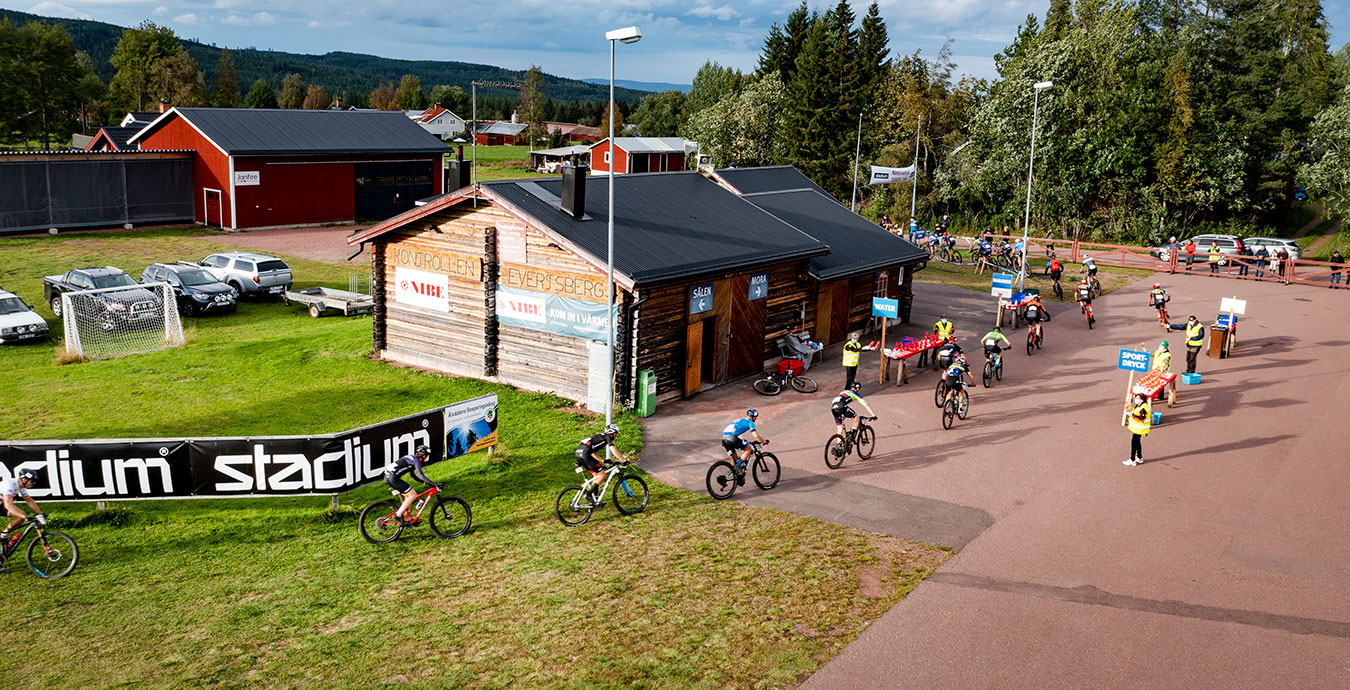In the same year, 2008, Vasaloppet took over arranging Vasastafetten, the running relay for ten-person teams that Korpen Mora has organized since 1991. (Sports associations in Malung, Älvdalen and Mora arranged the first Vasastafetten on June 29, 1991. The start saw pouring rain and 29 teams took part. The year before, a test run had been completed with five teams. Vasastafetten quickly grew to have several hundred registered teams.)
Cykelvasan
The idea of cycling from Sälen to Mora had existed for many years. In the summer of 2008, all conceivable (and inconceivable) cycling routes between Sälen and Mora were considered. In the late autumn of 2008, about 20 cyclists tested the intended course for Cykelvasan.
Norwegian Birkebeinerrittet in Lillehammer was an important role model (as it was the summer equivalent of the ski race Birkebeinerrennet). Cykelvasan was also a good fit in the development plan for establishing the Vasaloppet Arena.
There were some reroutes of the course compared to the test run. It was to be an easy route that appealed to the majority of cyclists. Both the track layout and the marketing focused on ”bike” rather than ”mountain bike”. Cykelvasan would be something unique! And it was important that the event maintain ”Vasaloppet quality”.
It was decided that the first Cykelvasan should run directly in 2009 and together with Vasastafetten (where ten runners divide Sälen–Mora into ten sections) and the now discontinued Stavgångsvasan it became the ”Vasaloppet Summer Week”.
It was by no means obvious that the first Cykelvasan in 2009 would be a success – but it was, and it immediately became Sweden’s largest mountain bike race! Of course Sweden’s elite were there, together with almost 2,000 recreational athletes. The classic stretch offered the same experience as in winter: Start in Sälen, via all the famous checkpoints, with blueberry soup, and a finish with Kranskulla and Kransmas in Mora. A 90 km long challenge that turned out to suit most people.
The 2009 Vasaloppet winner Daniel Tynell participated in the very first Cykelvasan and Sveriges Television followed him during the new race. ”Mora-Nisse” sat behind the finish line, receiving the cyclists – this was an important signal to show that the ”historic Vasaloppet” stood behind and supported these ”newfangled” developments.
The success of Cykelvasan continued in its second year, 2010, when over 4,000 cyclists registered. The 2011 Cykelvasan attracted almost 8,000 registrants and the Sälen start was then moved from Tjärnheden to the Vasaloppet start in Berga by.
Over the years, there has been much investment in reducing asphalt sections in the Vasaloppet Arena. Gravel roads and paths have been built to make the surface as good as possible. In 2009, half of Cykelvasan was on roads with traffic but now over 80 of its kilometres run through the terrain. Cykelvasan has a competition as well as an exercise class from Sälen to Mora as well as two shorter exercise races over 30 and 45 km, both starting in Oxberg.
Ungdomscykelvasan ran for the first time in 2012. In it, young people aged 11–16 cycle from Oxberg to Mora, 32 km. In connection with Cykelvasan, Barnens Vasalopp, the bike race for children aged up to about 10, has been held in Sälen and Mora since 2010 (originally called ”Barnens Cykelvasa ”). Everyone cycles just under a kilometre, has a number bib and gets a medal. The role model was the winter equivalent, Barnens Vasalopp on skis, which attracts tens of thousands of future ski fans.
Since 2010, Cykelvasasprinten has also run, a special invitational race where elite cyclists can show off their skills to spectators in Sälen. In 2015, the new race Cykelvasan Öppet Spår was introduced, allowing people to cycle the whole distance without any stressful competitive elements.
Since the 2016 race, Cykelvasan 90 has a maximum number of registrants of 13,000 participants. The race was then 94 km, but since 2023 the distance is 96 km: The course was changed immediately after the start for Cykelvasan 90 and Cykelvasan Öppet Spår; it was the premiere for cyclists to climb the famous first hill, just like the skiers in winter, up to the highest point of Vasaloppet. The three races, Cykelvasan 30, Cykelvasan 45, and Ungdomscykelvasan, were moved the same year from Sunday to Friday.
Ultravasan and more races for runners
Between 2002 and 2006, Vasastafetten had a class for lone runners, which had nine registered participants at most. This was the precursor to Ultravasan, though that class was discontinued when Vasaloppet took over Vasastafetten in 2008.
A happy coincidence led to Ultravasan seeing the light of day. Namely the fact that Mora was home to one of the world’s foremost sports organizers, Vasaloppet, as well as home to one of the world’s foremost ultrarunners, Jonas Buud! He brought experiences from ultrarunning races all over the world and was eager to give other ultrarunners the opportunity to run a race in the classic terrain between Sälen and Mora. ”If you can ski and bike between Sälen and Mora, surely you can run it too,” enthusiasts said.
It was not hard to find interested test runners, for there were many who wanted to run an ultramarathon on classic ground. In connection with Vasastafetten 2010 there were therefore about twenty experienced ultrarunners, invited from all around the Nordic region, running a test race to see how it would all work. Yes, a few had actually even run the whole stretch before that. The name of the race was ”SM90”, with SM standing for Sälen–Mora and 90 indicating the number of kilometres – though unofficially the name ”Ultravasan” was already being considered in connection with this test race. (Ultra is the name of races longer than the marathon distance of 42,195 metres, and ”trail” or ”terrain” means that the main part of the race is not on asphalt.)
After a few years of thinking and planning it was time, in 2014, for Vasaloppet to challenge the runners of the world! That was the starting shot for the first real Ultravasan between Sälen and Mora. The trend with individual extreme races is very strong in many parts of the world and the goal with Ultravasan was to become the largest ultra trail race in Scandinavia and attract a strong international elite.
Ultravasan has two races, one 90 km and one 45 km. The 90 km race starts in Sälen, like the traditional Vasaloppet, and follows the course eastwards towards Mora. The 45 km race starts in Oxberg and largely follows the same stretch as Halvvasan along the Oxberg lake to Vasslan before joining the Ultravasan 90 course. Both races have a class for women and one for men.
Close to 1,500 runners registered for the first race, which was a huge success, not least for home runner Jonas Buud, who won. The next year, 2015, he repeated his victory and set an impressive track record, running 90 kilometres in 5.45.08. Another addition from 2014 is the Barnens Vasalopp running race (originally called Barnens Springvasa) in Sälen and Mora for the very youngest.
2017 saw the introduction of Vasakvartetten, where four runners divide the Sälen–Mora stretch into what is roughly equivalent to four half marathons. 164 four-person teams registered for the first Vasakvartetten. In 2018, Cykelvasan and the whole Summer Week could celebrate a tenth anniversary with over 33,000 registered participants. But in 2020 and 2021, the Summer Week had to be replaced with Hemmavasan.
When the Summer Week returned in 2022 there was a proper premiere on location for the two new individual running races in the Vasaloppet Arena: Trailvasan 30, 30 km from Oxberg to Mora, and Trailvasan 10, a 10 km race that starts and finishes in Mora.
Vasakvartetten was held for the last time in 2022, but four people can still share the task if they choose to run in the recreational class of Vasastafetten. Vasastafetten has three classes:
Competition, women – Ten participants per team. Only women.
Competition, men – Ten participants per team. Women are allowed.
Leisure class – Two to ten participants per team. Any number of men and women. It is allowed to run multiple sections per person.
For the Vasaloppet summer week 2023, the course layout at the start in Sälen was changed for Ultravasan 90 and Vasastafetten; it was the premiere for runners to first run along the Västerdalälven river and then climb the famous first hill, just like the cyclists and skiers, up to the highest point of the Vasaloppet. The distance for the runners thus became 92 km from Sälen to Mora.
After a test run in 2023, Funkisvasan became a new regular race starting in 2024: a 4 km running race aimed at people with some form of disability.
The Vasaloppet Summer Week has established itself as one of the summer’s big events for both elite and recreational athletes. Welcome!
Text: Lars Ingels
When was the race first held?
| 1991 | Vasastafetten (arranged by Vasaloppet since 2008) |
| 2009 | Cykelvasan 30, Cykelvasan 45, Cykelvasan 90 |
| 2010 | Cykelvasasprinten |
| 2012 | Ungdomscykelvasan |
| 2014 | Ultravasan 45, Ultravsan 90 |
| 2015 | Cykelvasan Öppet Spår |
| 2017 | Vasakvartetten |
| 2020 | Trailvasan 30 (in Hemmavasan) |
| 2020 | Trailvasan 10 (in Hemmavasan) |
| 2024 | Funkisvasan |
Footnote: Vasaloppet’s Summer Week 2020 did not take place due to the covid-19 pandemic. Participants in Hemmavasan could count their at-home races as regular races. The Summer Week in 2021 was also replaced by Hemmavasan, but elite competition versions of Cykelvasan 90, Ultravasan 90 and Ultravasan 45 were held. Participants in Hemmavasan 2021 could count their at-home races as regular races.
What years saw dream records set for Vasaloppet’s Summer Week?
| 2009 | Over 5,000 registered for Vasaloppet’s Summer Week for the first time |
| 2011 | Over 10,000 registered for Vasaloppet’s Summer Week for the first time |
| 2013 | Over 20,000 registered for Vasaloppet’s Summer Week for the first time |
| 2017 | Over 30,000 registered for Vasaloppet’s Summer Week for the first time |
The page was updated 2024-08-28




